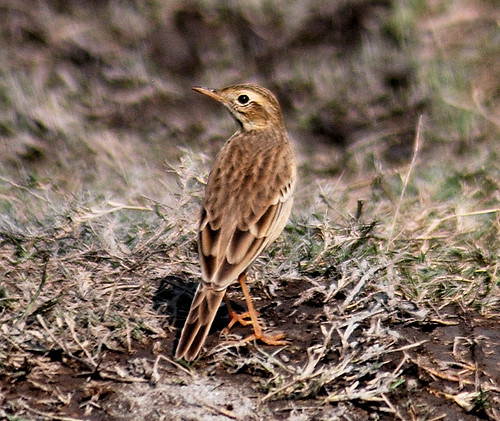tags: Paddyfield Pipit, Anthus rufulus, birds, mystery bird, bird ID quiz
[Mystery bird] Paddyfield Pipit, Anthus rufulus, photographed on the Yamuna River, New Delhi, India. [I will identify this bird for you in 48 hours]
Image: Adrian White, November [larger view].
Nikon D40x with 70-300AF.
Please name at least one field mark that supports your identification.
HINT: I think you can narrow this bird down to one of two very similar species.


The slender build, slender bill, upright stance, and long tertials covering the folded primaries suggest Motacillidae, and the streaky plumage indicates a pipit -- but I'm afraid that's as far as I can go.
engforum.pravda.ru/showthread.php?t=280780
Einstein puts the final nail in the coffin of atheism...
*************************************
youtube.com/watch?v=V7vpw4AH8QQ
*************************************
atheists deny their own life element...
LIGHT!
One possibility is a species which is the title of a 1944 movie. I suspect its a congener but sorting out the plumages is beyond me.
Western Meadowlark?
Once again trolls prove that the only thing between their ears is solid rock.
Nice thinking, Jana, but a Meadowlark should show some definite yellow on the face and throat, should be stockier overall, and should have distinct barring on the tertials, wing coverts, and tail feathers.
And, I'm afraid you borrowed a page from my book and misread the location. (I've done that a few times, so you've got some catching up to do.) Meadowlarks are N. American (the whole Icteridae family is strictly Western Hemisphere), and this bird was photographed in India.
Paul, thank you - I was joking actually, as I saw it was an Indian bird. Not, you know, the funny kind of joke...
I'm a beginning birder in North America, much less anywhere else! Though if anyone has good resources for birds that aren't in my particular backyard, I'd welcome them.
I think a few clues may be needed.Yes it's an Anthus pipit. It's one of a complex which was originally named (in latin) before the split antipodes islands. In English after two Plantagenet kings. It's usual habitat gives the final clue.
Another clue? There are 14 Pipits recorded in India. Of these all but 6 are out of range at Dehli. Olive-backed, Tree and Tawny Pipits are not as brown as this bird. Tawny is a lot paler, so that leaves the two that Grrl mentioned above. Does that help?
Tawny Pipit is the 1944 British movie I mentioned - my guess was Richards (apparently Blyths is very similar) but if you use google to pull up images labelled as Tawny Pipit in India - some of the of them look very similar to this bird - of course there is no guarantee the photographer saw/heard enough to make a good ID.
Two of us saw this bird. We were alerted by the flight call and spent at least 2hrs puzzling over it. We eventually narrowed it down to one of two species. Based on the call and overall appearance we got it down to this species.
My clues referred to the Richard's Pipit complex, Richard's, Blyth's and Paddyfield. Originally "lumped" as Novaeseelandiae, they are now recognised as three species, (hence my reference to the "split antipodes islands" New Zealand.) Although the breast is not seen here it is has heavier streaking than Tawny and the upright stance was a help. My last clue about habitat led to the common name of this one, Paddyfield Pipit of the Indian ssp "rufulus".
We are both birders with plenty of experience of the birds in this complex and although we can make mistakes we are sure of the ID of this one.